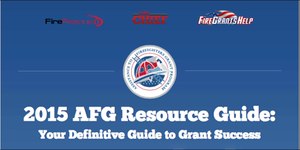
This excerpt from the 2015 AFG Resource Guide introduces the steps fire departments must follow to getting a grant funded; the full guide is free
The foundation for a successful grant application begins by reading the program guidelines. In layman's terms, these are the instructions for the grant process.
FEMA now calls this document the Funding Opportunity Announcement, or FOA. This document provides all of the information concerning grant eligibility, program priorities, filing deadlines and application assistance.
The next step is to determine your eligibility. Answering these four questions will determine how and if can you proceed.
If you are ready to move forward with an application, you need to understand the different types of funding components within AFG and your eligibility to apply under them.
Fire departments and nonaffiliated EMS organizations may apply for each, any or all of the five Operations and Safety component activities (training, equipment, personal protective equipment, wellness and fitness, and modification to facilities).
Assessing risk
You can also apply under the vehicle component, and act as a regional host for an application. Regional applicants may only apply for training, equipment, PPE and vehicles.
The next activity is to conduct a risk assessment of your service area and department. This assessment will be the basis of your grant application, showing trends your department has experienced over the past three to five years. To initiate your assessment, you will need to develop a demographic profile of your coverage area and your department.
To start your profile, access the U. S. Census data at Census.gov. For every community in your first-due area you should know at minimum these five items.
Next, develop a list of critical infrastructure in your first- due area. This should include these types of places.
Equipment inventory
The next segment of the planning process involves an assessment of your department's equipment, PPE and apparatus. Begin by examining your department's fire reports for the past year. At a minimum, look at the number and type of alarms you had, as well as any special circumstances that occurred.
Compare this data to the past three to five years of alarms. Then examine your current inventory of equipment, PPE and apparatus. Do they meet current standards? Have maintenance and repair costs negatively impacted your budget? Are they posing a safety hazard to your firefighters or the community?
All of this data should give you a picture of your community and the factors that are impacting your delivery of services to your coverage area. This data will be extremely useful as you develop your application narratives.
Before you can begin the actual AFG narrative, your organization must have a current, active DUNS number and must be registered with SAM — the System for Award Management. Registration in SAM is free.
Per federal regulations, FEMA will not process any payment request or consider any amendment until the grantee has complied with the requirements to provide a valid DUNS number and an active SAM registration with current information. All applicant information in SAM, DUNS and the FEMA profile must match. That includes addresses, phone numbers, and email addresses.
Also, mark the SAM profile as public. If your profile is private, FEMA grants management specialists will not be able to verify your active SAM registration. Sensitive banking and financial data are not revealed in the public profile.
Tell your story
The AFG application consists of a series of questions and narratives. In the past, the narratives were all contained in one section of the application. Four years ago FEMA revamped the AFG application format and several of the narrative sections are now found interspersed within the application questions.
If you have not filed an AFG application in recent years, be prepared for the amount of information that you will be requested to provide. Since you cannot access a 2015 AFG application until the grant opens, go to the AFG website and review the Get Ready Guides that FEMA has prepared.
Inside this material are questions similar to the ones in the AFG application. This will allow you to gather the information you will need from your department to ease your application preparation.
You will notice that AFG has specific questions about your department, the area you cover, the alarms you answer, your financial situation and the apparatus you use. These are broken out into Applicant Information, and Applicant Characteristics sections.
Once you have completed these sections and entered a project, you will encounter the Request Details section. This section asks specific questions about the project you are requesting and the cost involved.
As you input cost estimates for your project into the Request Details section, the application is transferring this financial data into the Budget section of your application. If the amounts do not agree, return to the Request Detail section to make adjustments. Also included in the Request Details sections are narratives pertaining to the specific project you are requesting.
You can download the entire free 2105 AFG Resource Guide in PDF or digital flipbook format.
Copyright © 2024 FireGrantsHelp.com. All rights reserved.
